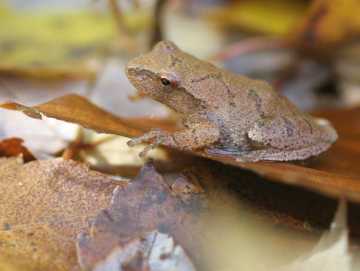

PHOTO COURTESY OF GARRY KESSLER
Tiny spring peepers are usually heard but not seen. The inch-long male frogs call from Westborough's wetlands for several weeks in the early spring when they are courting females. In this photo half of the "X" on the peeper's back is visible.
April 14, 2006, Page 13
NATURE NOTES
By ANNIE REID
Westborough Community Land Trust
Tiny frogs herald springtime
Nothing says it's spring like the sound of a chorus of spring peepers from a nearby swamp on a mild April evening.
The sound carries far, sometimes up to a mile away. It comes from surprisingly tiny frogs. Spring peepers (Pseudacris crucifer, formerly Hyla crucifer) are only about an inch long.
If you see one of these tiny frogs, you can recognize it by the dark "X" on its back. But spring peepers are hard to find. Not only are they small, but they're also active mostly at night. Their tan, gray, or brown colors help them blend into their woodland surroundings.
Like so many other sounds of spring - birdsong, the croaking of wood frogs - the calling of spring peepers heralds the breeding season. The males are the performers. With their loud peeping, the males are calling to the females. And the females prefer males that call fast and loud.
In Westborough, it's not hard to be within earshot of wetlands where spring peepers gather to carry on their courtship at this time of year. We have two major rivers with headwaters here (the Assabet and the Sudbury Rivers), 80 possible vernal pools, and five sizable swamps that together cover about one-eighth of the town.
These swamps are Cedar Swamp (in the middle of town), Orchard Swamp (just north of parts of Route 9), Crane Swamp (on the border with Northborough), Assabet Swamp (near Mill Pond, which now covers parts of it), and an unnamed swamp near the outflow from Hoccomocco Pond (south and north of parts of Route 9).
How do spring peepers make such loud calls? These little fellows - the males - blow air over their vocal cords into a sac at their throats. This sac expands - so much that you can see it - and acts as kind of sound box. A peeper's inflated vocal sac is about as big as a quarter.
We tend to think of frogs as creatures that live in the water, but spring peepers are actually tree frogs. They spend most of their lives in the woods, often in the shrubbery. There they catch insects with their long sticky tongues and eat them.
How do frogs climb trees? Spring peepers have swollen toe pads, like other tree frogs. These special disk-shaped toe pads provide suction, helping the peepers cling or stick to vegetation.
Spring peepers come to standing water to breed. The females lay eggs in the water and leave. After about a week, the eggs hatch. The young spend their first 5 to 8 weeks as tadpoles in water, feeding mostly on algae. They gradually transform from tadpoles with gills and a tail into frogs with lungs and four legs. From June into the summer, the young peepers leave the water and take to the woods.
And how do spring peepers survive the New England winter, to appear in our wetlands each spring, alive and calling loudly? They spend the winter hibernating under logs, loose bark, or dead leaves on the ground. Like many other creatures - mourning cloak butterflies, wood frogs, woolly bear caterpillars - their bodies make chemicals that act as antifreeze.
In the case of spring peepers, the main antifreeze is glucose, or blood sugar. In a version of the alarm reaction that readies other animals for "fight or flight", a spring peeper's body pumps out loads of blood sugar when freezing temperatures hit. That much blood sugar would make humans diabetic, but it helps spring peepers to survive freezing temperatures. In fact, spring peepers do freeze, but the trick is that ice forms between their cells, not inside them, so no damage is done.
If they aren't eaten by birds, snakes, fish, or other frogs, spring peepers live several years. They generally survive not just one, but several winters. And each year they help us welcome spring with the peeping calls that give them their name.
Nature Notes follow-up: What's blooming in the woods already? Skunk cabbage and pussy willows got any early start in February but then were delayed by the return of cold weather in March, so they're still blooming. Last weekend the red maples were in bloom, their small red flowers giving a reddish cast to many wet areas. Willows, aspen, birch, and alder are also in bloom.